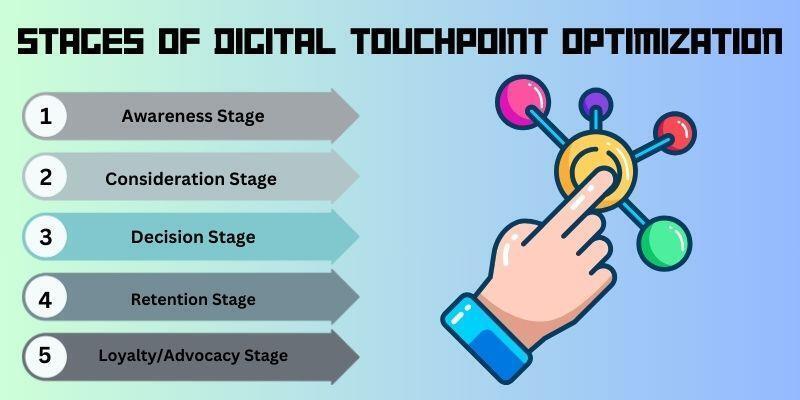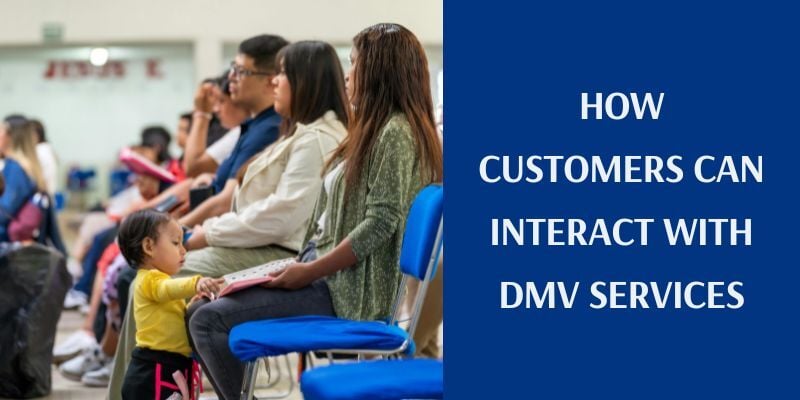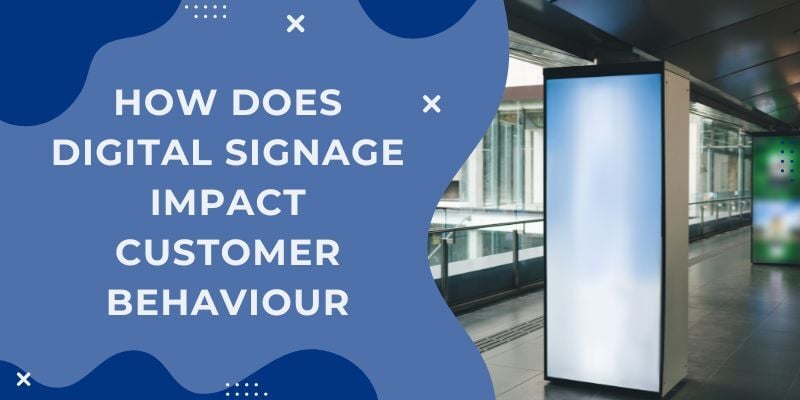In the competitive world of digital marketing, understanding and leveraging digital touchpoints can be a game-changer for businesses.
Did you know 71% of customers expect personalization at customer touchpoints? This statistic highlights the importance of crafting a smooth experience across all platforms where your brand interacts with potential clients.
Digital touchpoints are any instance where a customer interacts with your brand online through websites, social media, email, or other digital channels.
Optimizing these interactions is critical for creating a cohesive and engaging user journey that can lead to higher conversion rates and long-term customer loyalty.
What are Digital Touchpoints?
Digital touchpoints are the various online interactions between a brand and its customers throughout the customer journey.
These touchpoints are essential in guiding potential customers from the initial awareness stage to the decision to purchase and even beyond into the post-purchase engagement phase.
Examples of Digital Touchpoints
Here are some common examples of digital touchpoints in the B2B landscape:
- Website Visits: Your website often serves as the first point of contact for many customers. An informative and well-structured site can create a positive user experience.
- Social Media Engagement: Platforms like LinkedIn and Twitter are vital for engaging with prospects in the B2B world, sharing valuable content, and building relationships.
- Email Newsletters: Regular communication through newsletters can keep your brand top-of-mind and provide value to existing and potential clients.
These interactions play a significant role in shaping how customers perceive your brand. When managed effectively, digital touchpoints can create a uniform customer experience, increasing brand loyalty and driving conversions.
What is The Marketing Rule of 7?
The Marketing Rule of 7 is a classic marketing principle that suggests potential customers need to see a brand’s message at least seven times before they take action.
This concept is more relevant than ever in multi-channel marketing touchpoints, where businesses engage customers through multiple digital channels.
Why Repeated Exposure Matters
Repeated exposure through diverse marketing touchpoints helps build familiarity and trust, which are critical in decision-making.
When prospects consistently encounter your brand across various platforms, they’re more likely to remember your message and consider your offerings.
Example: HubSpot’s integrated marketing strategy ensures that potential customers encounter their brand through blogs, webinars, email marketing, and social media, reinforcing the brand’s message consistently across all customer journey touchpoints.
Why is it Important to Understand and Optimize Digital Customer Touchpoints?
Recognizing and optimizing digital customer touchpoints can significantly impact the overall customer experience and boost conversion rates. A well-designed strategy that considers all touchpoints helps identify potential gaps and opportunities for improvement.
Benefits of Optimization
- Increased Customer Satisfaction: Customers who have a smooth experience across all touchpoints are likelier to feel valued and satisfied.
- Higher Conversion Rates: Optimized touchpoints ensure potential leads have all the information they need at the right time, increasing their chances of converting into customers.
How to Map Your Customer Journey?
 Interpreting the customer journey touchpoints is critical to designing an effective digital strategy. Mapping this journey helps identify where potential customers interact with your brand and reveals opportunities to improve these interactions.
Interpreting the customer journey touchpoints is critical to designing an effective digital strategy. Mapping this journey helps identify where potential customers interact with your brand and reveals opportunities to improve these interactions.
Step-by-Step Guide to Mapping the Customer Journey
- Identify Your Buyer Personas: Define and segment your target audience into different buyer personas. Knowing your audience allows you to tailor each touchpoint in marketing to meet their needs.
- Outline the Stages of the Customer Journey: Typically, these stages include Awareness, Consideration, Decision, and Retention. For each stage, identify the key digital customer touch points that customers interact with.
- Collect Data on Customer Interactions: Use tools like Google Analytics or CRM systems to gather data on how customers engage with your brand at each touchpoint.
- Analyze Pain Points: Identify where users might drop off in their journey or face challenges, such as a complicated website layout or slow response times on social media.
- Optimize and Update: Continuously refine your customer journey map based on the data insights and feedback to improve the customer experience.
Tools and Techniques for Customer Journey Mapping
- CRM Platforms: Tools like Salesforce or HubSpot can help track interactions at each user journey touchpoint.
- Data Visualization: Tools like Lucidchart or Miro are great for mapping the customer journey visually, making it easier to identify gaps and opportunities.
Real-life Example: IBM effectively maps its customer journey using data analytics to track customer behaviors across its website, email campaigns, and social media platforms. This helps them optimize their marketing touchpoints to serve their clients better.
How to Optimize Digital Touchpoints Relevant to Your Business
 Optimizing your digital touchpoints means ensuring every interaction with your customer is as smooth and effective as possible. It’s about meeting customer needs at each stage of the customer journey while guiding them toward a purchase.
Optimizing your digital touchpoints means ensuring every interaction with your customer is as smooth and effective as possible. It’s about meeting customer needs at each stage of the customer journey while guiding them toward a purchase.
Awareness Stage: Creating the First Impression
Potential customers first encounter your brand during the awareness stage. Optimizing touchpoints at this stage can significantly influence their perception.
1. Google and Other Search Engines
- Role in Awareness: Search engines often serve as potential customers’ first point of contact. They help create brand awareness through both organic search results and paid ads.
- SEO and PPC: Optimize your website’s content using SEO best practices to rank higher in search results. Combine this with PPC campaigns to target keywords like digital and purchase touchpoints.
Tip: Include clear meta descriptions and engaging headlines to capture attention quickly.
2. PPC Ads on Multiple Channels
- Effectiveness: Pay-per-click (PPC) ads are crucial for reaching a wider audience quickly. They appear on search engines, social media, and other platforms, boosting your brand’s presence.
- Ad Strategy: Create compelling ad copy that addresses your target audience’s pain points. Use clear CTAs that encourage clicks and engagement.
Example: Shopify runs PPC campaigns across multiple channels to promote its e-commerce solutions, targeting entrepreneurs looking to set up online stores. This approach significantly increases brand visibility.
3. Marketplaces
- Role in the Customer Journey: Online marketplaces like Amazon, eBay, and B2B platforms like Alibaba act as significant touchpoints in the digital customer journey.
- Optimization Tips: Ensure your product listings are optimized with high-quality images, detailed descriptions, and positive customer reviews.
4. Social Media
- Importance: Social media platforms like LinkedIn, Facebook, and Twitter play a vital role in creating brand awareness, especially in B2B marketing.
- Engagement Strategy: Share industry-relevant content, interact with followers, and use targeted ads to reach your ideal audience.
5. Peer Recommendations
- Impact: Word-of-mouth and peer recommendations can significantly influence potential buyers in the awareness stage.
- Strategy: Encourage satisfied customers to share their experiences on social media or review sites.
6. Influencer Promotion
- Role of Influencers: Partnering with industry influencers can help amplify your brand’s message to a broader audience.
- Collaboration Tips: Identify influencers in your niche and create authentic campaigns that align with your brand values.
7.YouTube Ads
- Effectiveness: YouTube ads are a powerful tool for brand awareness, reaching over 2.49 billion users monthly. Their engaging format is highly effective in capturing attention.
- Best Practices: Hook viewers in the first 5 seconds, use clear messaging, and optimize for mobile.
- YouTube Reach: YouTube reaches 77.7% of viewers who’ve made purchases after seeing ads, especially among the 18-49 age group.
Ad Formats:
- Skippable Ads: Viewers can skip after 5 seconds, so capturing attention quickly is key.
- Non-Skippable Ads: These must be watched entirely, ideal for ensuring full message delivery.
- Bumper Ads: Quick, 6-second, non-skippable ads for a memorable impact.
8. Business Blog Writing
- Increasing Awareness: Blogging helps increase brand visibility and authority by providing valuable insights and solutions to industry-related challenges.
- Content Strategy: Focus on answering common industry questions and providing in-depth, actionable insights to attract potential customers.
- SEO Importance: Ensure blog posts are optimized with keywords to drive organic traffic and position your business higher in search results.
Consideration Stage: Moving Toward Decision-Making
In the consideration stage, potential customers evaluate different options and decide if your product or service is right for them. Optimizing your marketing touchpoints at this stage can help you stand out and keep prospects engaged.
1. Search Engine Ads Used to Compare Products
- Role in Consideration: Search engine ads are highly effective in helping potential customers compare products during this phase. These ads can highlight the unique features and benefits of your offering.
- Optimization Tips: Create comparison ads that differentiate your product from competitors. Use direct language that emphasizes your key value propositions.
2. Email Marketing
- Nurturing Leads: Email marketing is vital in keeping leads engaged by delivering personalized content that addresses their needs and concerns.
- Segmentation Strategy: Segment your email list based on customer interests, behaviors, and position in the customer journey touchpoints. This allows for more relevant and targeted communication.
Example: Salesforce’s email campaigns are tailored to provide different content to new prospects, existing customers, and returning leads, enhancing their decision-making process.
3. Thought Leadership
- Building Authority: Establishing yourself as a thought leader in your industry during the consideration phase can build credibility and trust with potential clients.
- Content Strategy: Develop high-quality content, such as whitepapers, eBooks, and webinars, that address industry challenges and provide solutions.
Example: Deloitte creates in-depth research reports and hosts webinars to position itself as a leader in business consulting, attracting B2B clients who value expert insights.
4. Remarketing/Retargeting
- Re-engaging Potential Customers: Remarketing ads target users who have previously interacted with your brand but have yet to convert, serving as reminders of your value.
- Practical Strategies: Use retargeting ads that feature dynamic content, showcasing products or services the user viewed on your website.
5. Improved Product Listings
- Importance: Optimizing product listings during consideration ensures that all relevant information is accessible and persuasive.
- Best Practices: Focus on clear descriptions, high-quality images, and positive customer reviews to build trust and influence purchasing decisions.
Decision Stage: Converting Prospects to Customers
At the decision stage, prospects are ready to make a purchase decision. This is where your digital touchpoints must be optimized to provide a unified transition from interest to action.
1. Website
- Influencing Decisions: A well-designed website is a critical touchpoint that can make or break conversion. Focus on creating a user-friendly layout with clear calls to action.
- Pricing Page Tips: Ensure your pricing page is transparent, highlights your unique value propositions, and offers easy comparison options.
2. Customer Support
- Role in Decision-Making: Responsive and accessible customer support can significantly impact a prospect’s decision to choose your brand over competitors.
- Support Strategies: Offer live chat options, comprehensive FAQs, and quick response times to address last-minute concerns or questions.
Example: Zendesk excels in customer support by offering 24/7 live chat and detailed help articles, which helps prospects make informed decisions.
3. Feedback & Customer Reviews
- Impact on Conversion: Reviews and feedback from existing customers are powerful decision-making tools that can tip the scales in your favor.
- Encouraging Reviews: Prompt satisfied customers to leave positive reviews and ensure they are prominently displayed on your website and other platforms.
4. Checkout
- Optimizing the Checkout Process: A smooth and straightforward checkout process is essential to minimize cart abandonment rates and secure conversions.
- Best Practices: Simplify forms, offer multiple payment options, and ensure a secure transaction process to perfect the checkout experience.
5. Fulfillment & Shipping
- Influence on Customer Satisfaction: Efficient fulfillment and transparent shipping processes can boost customer satisfaction and reduce the chances of cancellations.
- Shipping Strategies: Provide tracking information and clear delivery timelines to manage customer expectations effectively.
Retention Stage: Keeping Customers Engaged
The retention stage is about maintaining a solid relationship with your customers after the purchase. Optimizing customer service touch points in this phase is critical for building loyalty and encouraging repeat business.
1. Custom Surveys
- Collecting Feedback: Custom surveys are a great way to gather valuable insights into customer satisfaction and areas for improvement.
- Best Practices: Design concise surveys that ask relevant questions to help you understand the customer’s experience and expectations.
2. Returns
- Hassle-Free Returns Process: A smooth returns policy can significantly enhance customer trust and encourage future purchases.
- Return Policy Tips: Make the return process simple and transparent by providing clear instructions and easy-to-follow steps.
Example: Zappos has built a strong reputation by offering a generous return policy that prioritizes customer convenience, promoting a sense of trust and reliability.
3. Mobile Apps
- Enhancing Engagement: Mobile apps serve as convenient touchpoints that keep your brand accessible to customers, providing a platform for personalized interactions.
- Key Features: Include features like personalized offers, loyalty rewards, and easy access to customer support within the app to boost engagement.
Loyalty/Advocacy Stage: Turning Customers into Advocates
The loyalty/advocacy stage focuses on turning satisfied customers into brand advocates. Marketing touchpoints can be pivotal in encouraging word-of-mouth promotion and referrals.
1. Rewards Programs
- Encouraging Loyalty: Rewards programs incentivize repeat purchases and encourage long-term customer loyalty by offering exclusive benefits and perks.
- Program Types: Implement different rewards programs, like points-based or tiered systems, to keep customers motivated and engaged.
Example: American Express uses a tiered rewards program that encourages customers to spend more to earn significant benefits, increasing customer retention and advocacy.
2. SMS Messaging
- Direct Engagement: SMS messaging is an effective way to communicate directly with customers, providing timely updates, promotions, and personalized offers.
- Best Practices: Keep messages concise and relevant and avoid overloading customers with too many texts to maintain engagement without being intrusive.
3. Referral Programs
- Leveraging Customer Advocacy: Referral programs harness the power of existing customers to attract new ones, offering incentives to both the referrer and the new customer.
- Designing Effective Programs: Create appealing and easy-to-understand referral incentives, ensuring customers are motivated to spread the word.
Example: Dropbox’s referral program is a classic success story. Existing users were rewarded with extra storage space for referring new users, leading to massive growth in the company’s user base.
Integrating Omnichannel Strategies
 In today’s competitive market, it’s essential to integrate digital touchpoints with offline experiences to create a unified customer journey.
In today’s competitive market, it’s essential to integrate digital touchpoints with offline experiences to create a unified customer journey.
An omnichannel approach ensures that every customer journey touchpoint is connected, delivering a consistent experience no matter how or where customers interact with your brand.
Importance of Integrating Digital Touchpoints
- Unified Customer Experience: An integrated strategy ensures that all touchpoints work together, creating a unified customer journey that flows effortlessly from one channel to the next.
- Higher Engagement and Satisfaction: Businesses adopting omnichannel strategies see a 30% higher customer lifetime value due to their cohesive and personalized experiences.
Implementing Omnichannel Strategies
In an era when customers interact with brands across multiple channels, adopting a well-integrated omnichannel strategy is no longer optional—it’s essential.
Successful implementation of omnichannel strategies can significantly enhance digital customer touchpoints, ensuring that each interaction aligns with the customer’s expectations and leads to a unified experience.
Here’s how businesses can effectively implement these strategies to boost customer satisfaction and brand loyalty.
1. Consistent Branding
Consistency in branding across all platforms is fundamental to a solid omnichannel strategy. It’s about ensuring that every interaction, whether online or offline, reflects the same brand voice, message, and visual identity.
This consistency helps build recognition, encourages trust, and reinforces the brand’s value proposition at every digital touchpoint.
Visual Identity: Use the same logos, color schemes, typography, and imagery across your website, social media profiles, email newsletters, and physical locations. This visual consistency helps customers instantly recognize your brand, regardless of where they encounter it.
Brand Voice: Whether it’s a tweet, a blog post, a customer service email, or an in-store conversation, the tone of your communication should remain uniform. A consistent brand voice humanizes your business and strengthens emotional connections with your audience.
2. Data Integration
Data integration is the backbone of any effective omnichannel strategy. When using Customer Relationship Management (CRM) tools, businesses can gather and analyze data from all customer journey touchpoints to create a unified view of each customer.
This holistic perspective allows brands to understand customer behavior patterns, preferences, and pain points, enabling them to deliver personalized experiences.
CRM Systems: Tools like Salesforce, HubSpot, or Zoho integrate data from multiple sources, such as website analytics, social media interactions, email responses, and purchase history. This data aggregation provides actionable insights that help craft tailored marketing messages for different customer segments.
Personalized Interactions: Data-driven insights allow businesses to predict customer needs and preferences, making offering relevant products or services at the right time easier. This level of personalization enhances the customer experience and increases the likelihood of conversion.
3. Cross-Channel Promotions
Cross-channel promotions ensure that your marketing campaigns provide a cohesive experience, regardless of the platform your audience uses.
The goal is to deliver a synchronized message that guides the customer journey, encouraging them to move smoothly from one touchpoint in marketing to the next.
Unified Marketing Campaigns: Through email marketing, social media ads, PPC campaigns, or in-store promotions, each channel should reinforce the same core message. Cross-channel promotions help create a more engaging experience that captures attention and guides potential customers toward conversion.
Customer-Centric Approach: Focus on delivering value at every customer journey stage. For example, retargeting social media ads for users who clicked on an email link or displaying in-store promotions based on recent online interactions can create a uniform customer experience.
FAQs
1. What is an example of a touchpoint?
A touchpoint is any interaction a customer has with your brand. For example, visiting your website, reading your blog, or engaging with a social media post are all digital customer touch points that help shape the customer experience.
2. What are the benefits of digital touchpoints?
Digital touchpoints provide numerous benefits, such as improved customer engagement, better brand visibility, and more data-driven insights into customer preferences. They help guide customers smoothly through their journey, leading to higher conversion rates and customer loyalty.
3. How many digital touchpoints before a sale?
Research indicates that it typically takes 7 to 13 customer journey touchpoints before a prospect is ready to purchase. This number can vary based on the industry and the complexity of the product or service.
4. Is social media a touchpoint?
Yes, social media is an essential touchpoint in marketing. Platforms like LinkedIn, Twitter, and Facebook are powerful channels for engaging with customers, sharing content, and building brand awareness.
5. What are the different types of touchpoints?
There are several types of digital customer touchpoints, including:
- Awareness Touchpoints: Search engine results, social media ads, and influencer promotions.
- Consideration Touchpoints: Email marketing, thought leadership content, and remarketing ads.
- Decision Touchpoints: Customer reviews, checkout process, and customer support.
- Retention Touchpoints: Loyalty programs, SMS messaging, and mobile apps.
Conclusion
Optimizing digital touchpoints enhances the customer journey and drives business growth. These touchpoints act as fundamental moments of interaction that shape customer perceptions and influence their decisions.
When continuously evaluating and refining these touchpoints, businesses can create a more engaging and personalized experience that builds long-term relationships and loyalty.
The importance of an omnichannel approach must be addressed in today’s competitive landscape. Integrating all your user journey touchpoints ensures a cohesive experience that meets customers’ needs at every stage, from awareness to advocacy.
Remember, a well-optimized journey is not just about converting prospects; it’s about creating enthusiastic brand advocates and spreading the word.
BOOK A FREE DEMO





